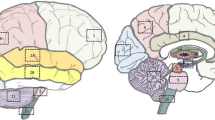Abstract
The relative contents (RCs) of mineral elements in aortae and cerebral arteries from 23 subjects, with ages ranging between 45 and 99 yr, were analyzed by inductively coupled plasma atomic emission spectrometry. The RCs of calcium, phosphorus, and magnesium in the aortae increased markedly after the age of 70. While the RC of sulfur in aortae decreased gradually after that age. It was found that accumulation of calcium and phosphorus occurred primarily in the tunica media of aorta, and secondarily in the tunica intima. Furthermore, the RCs of calcium, phosphorus, and magnesium in cerebral arteries increased markedly after the age of 70, whereas the RC of sulfur in cerebral arteries decreased after age 70. It was found that accumulation of calcium and phosphorus in the cerebral arteries were 30 and 60%, respectively, lower than those in the aortae with ages ranging between 45 and 99 yr.
Similar content being viewed by others
References
S. Y. Yu and H. T. Blumenthal, The calcification of elastic fibers. I. Biomedical studies,J. Gerontol. 18, 119–126 (1963).
R. J. Elliott and L. T. McGrath, Calcification of the human thoracic aorta during aging,Calcif. Tissue Int. 54, 268–273 (1994).
E. L. Kanabrocki, G. Fels, and E. Kaplan, Calcium, cholesterol, and collagen levels in human aortas,J. Gerontol. 15, 383–387 (1960).
Y. Tohno, S. Tohno, H. Matsumoto, and K. Naito, A trial of introducing soft X-ray apparatus into dissection practice for student (in Japanese)J. Nara Med. Assoc. 36, 365–370 (1985).
S. Tohno, Y. Tohno, T. Minami, M. Ichii, Y. Okazaki, M. Utsumi, F. Nishiwaki, and M.-O. Yamada, Difference of mineral contents in human intervertebral disks and its age-related change,Biol. Trace Elem. Res. 52, 117–124 (1996).
G. R. Martin, E. Schiffmann, H. A. Bladen, and M. Nylen, Chemical and morphological studies on the in vitro calcification of aorta,J. Cell Biol. 16, 243–252 (1963).
A. E. Hirst, I. Gore, G. Hadley, and E. W. Gault, Gross estimation of atherosclerosis in aorta, coronary, and cerebral arteries—A comparative study in Los Angeles and South India,Arch. Path. 69, 578–585 (1960).
S. Sadoshima, T. Kurozumi, K. Tanaka, K. Ueda, M. Takeshita, Y. Hirota, T. Omae, H. Uzawa, and S. Katsuki, Cerebral and aortic atherosclerosis in Hisayama, Japan,Atherosclerosis 36, 117–126 (1980).
I. Gore and C. Tejada, The quantitiative appraisal of atherosclerosis,Amer. J. Path. 33, 875–885 (1957).
Author information
Authors and Affiliations
Rights and permissions
About this article
Cite this article
Tohno, Y., Tohno, S., Minami, T. et al. Age-related change of mineral content in the human thoracic aorta and in the human cerebral artery. Biol Trace Elem Res 54, 23–31 (1996). https://doi.org/10.1007/BF02785317
Received:
Accepted:
Issue Date:
DOI: https://doi.org/10.1007/BF02785317




